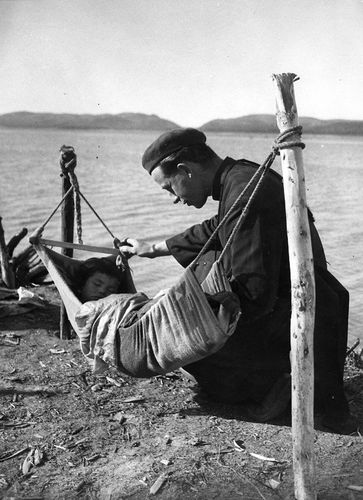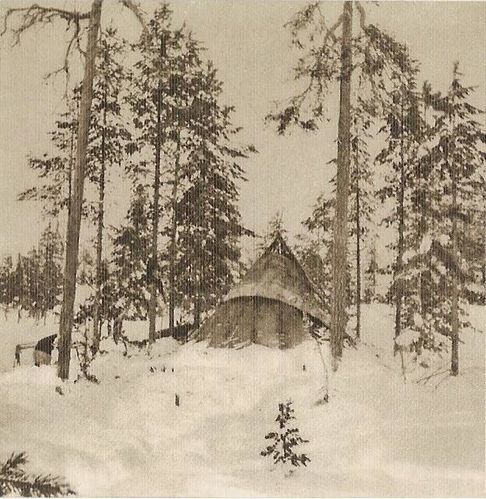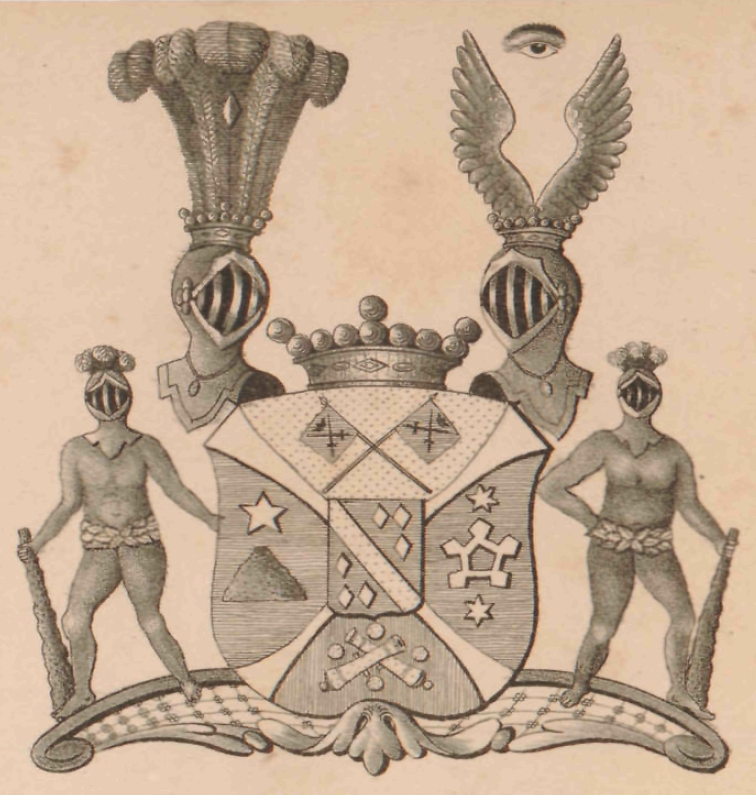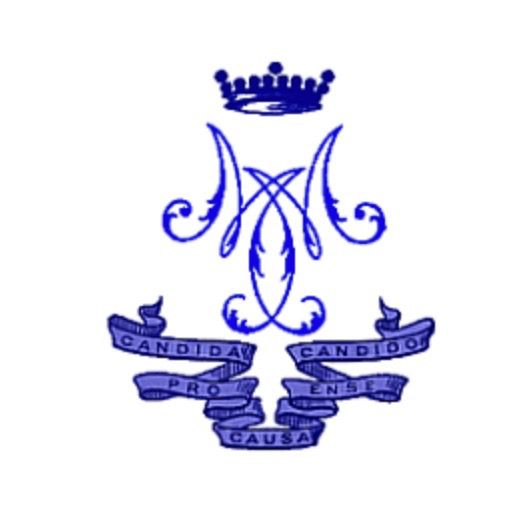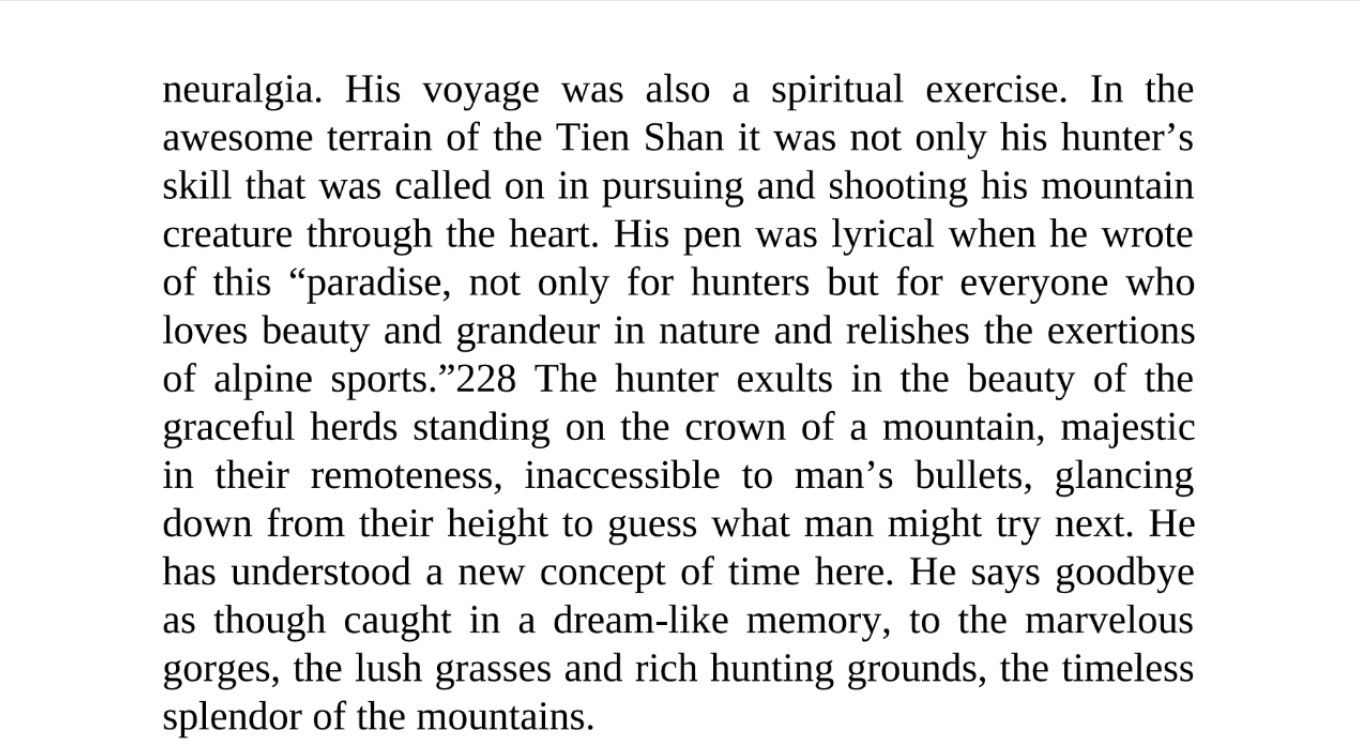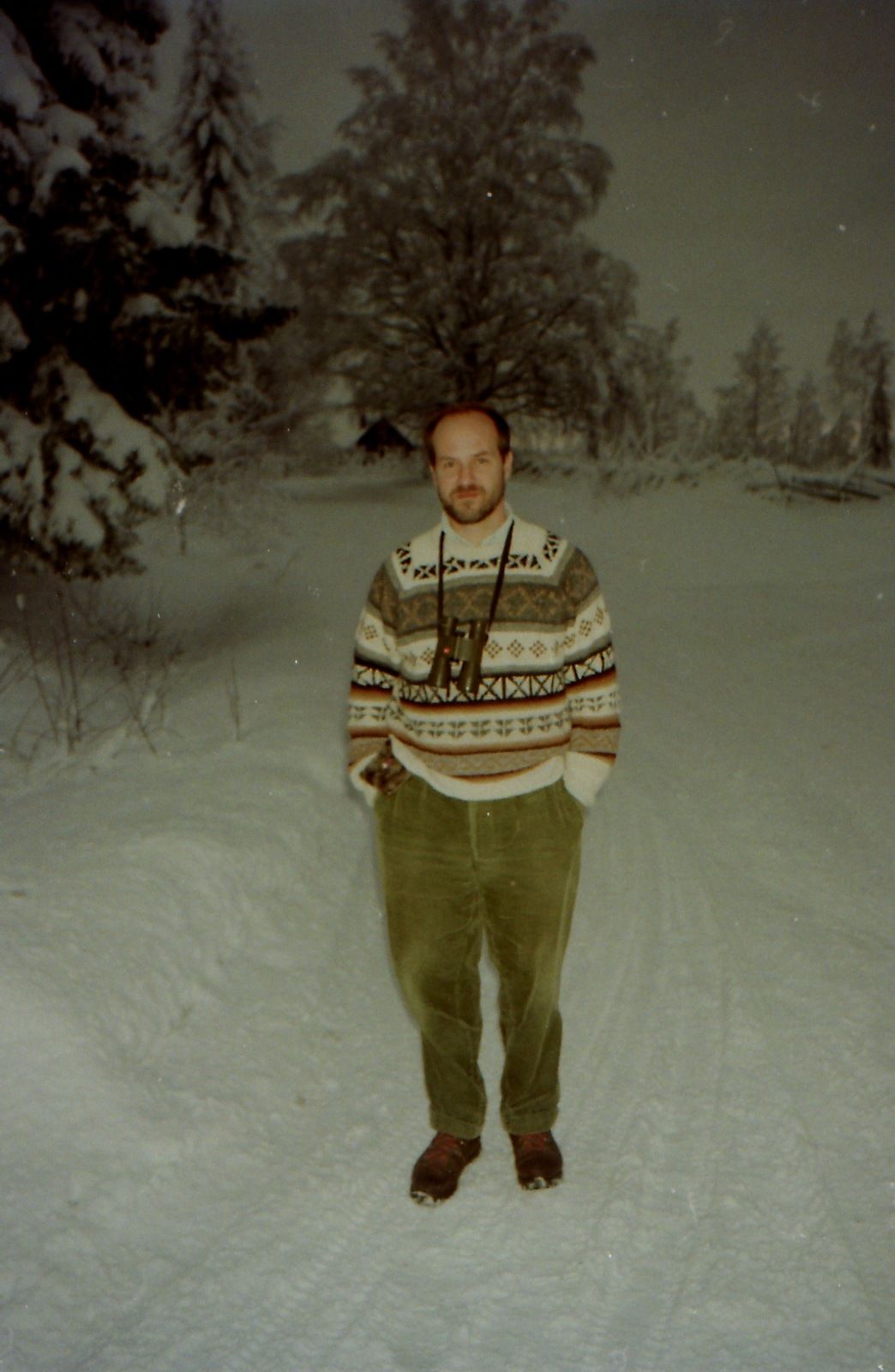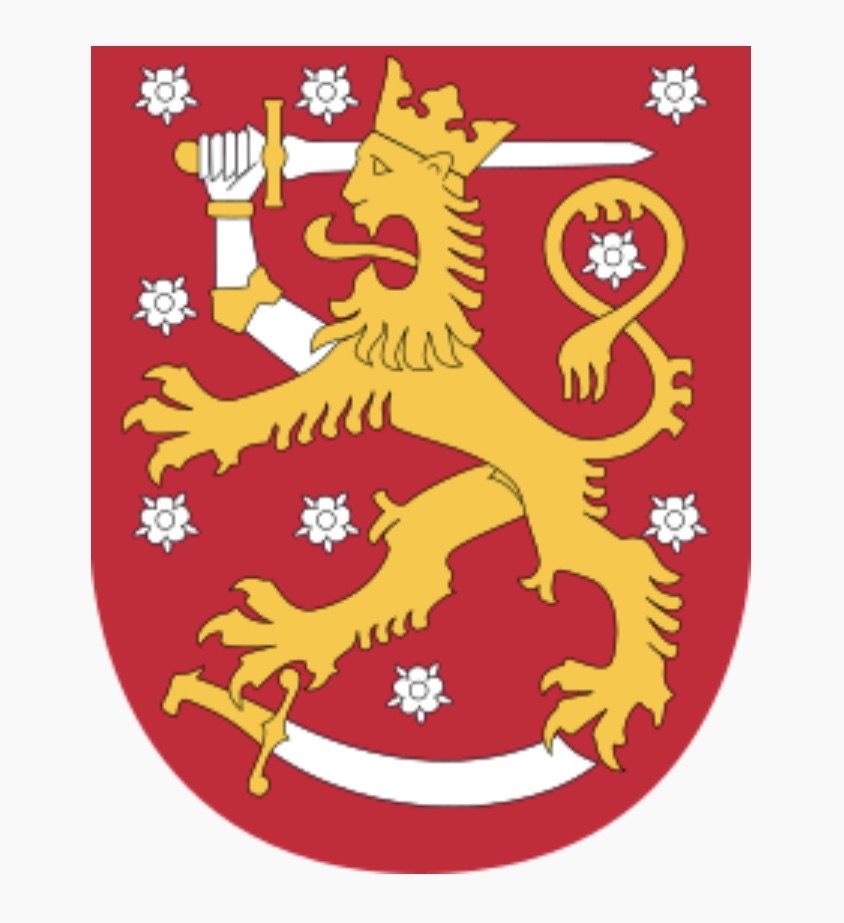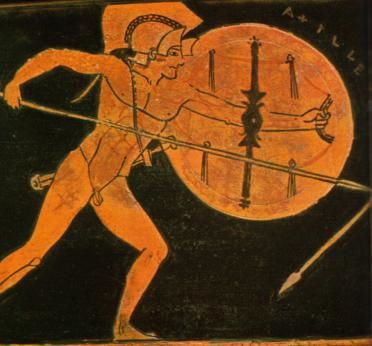"For the second time I had returned from the wilderness back to the civilization. I was probably even more glad to get home the second time. The world war may have had something to do with this. But in spite of everything I felt as I did the time before. A feeling of longing and depression was mixed with the joy. Only a short time ago I had lived on the large plains and the immesureable wilderness, and now I had returned to the market place of civilization. All the difficulties and strains were forgotten, and before my inner eye there stood the fresh life and the marvelous stay among savages whom I had learned to love and understand. He who only knows our side of existence cannot understand the other one. But he who has seen life in his more original form will never forget what he has seen, and once he has left the infinite plains the memory becomes a shining revelation to him from which he can never tear himself away again. He has become an individual with double life, something of him has remained in the wilderness. That is what happened to me."
Kai Donner, Among the Samoyeds in Siberia (1911-1913) 1926.
"The most beautiful memories of my journey are related to those wonderful nights when I could take part in the pagan worship services in the dim taïga. I very recall one such occasion. There were some men sitting at a peninsula of the river. The evening was quiet, the fire almost finished, and the shades of the bodies of ancient Siberian leaf pine trees were seen against the bright skies. The ground was covered by snow and all of nature seemed to sleep the dream od wilderness. Men had for a long time told old tales about their heroes long passed away, and the sage had talked to the spirits of the skies and the earth. I had forgotten everything I had left behind as a civilized man. I did not think about Christian and other dogmas. With childish admiration I had fallen into what I saw and heard. I felt as being a child again and I imagined in the same way as in my childhood that all things had a soul and air and water and were populated by mystical, visible and invisible spirits leading the world and human fates in a unexplainable manner."
Kai Donner, Among the Samoyeds in Siberia.
Cette notice biographique, imprimée sur un feuillet de couleur jaune, était insérée dans l'édition de l'édition française de l'ouvrage de Kai Donner: "La Sibérie" (1946). Je la reproduis à l'intention de tous ceux qui s'intéressent à la Sibérie et à ce grand ethnographe et explorateur, qui sut être aussi, aux côtés du grand maréchal Mannerheim, un ardent défenseur de sa patrie, la Finlande.
Quand on aime vraiment la liberté, on la désire autant pour les autres que pour soi-même.
Pierre-Olivier Combelles
Kai Reinhold Donner est né le 1er avril 1889, en Finlande, d'un père illustre, Otto Donner, et d'une mère qui appartenait à l'aristocratie, la baronne Wilhemina-Sofia-Charlotta Munck.
La lignée des Donner est issue de commerçants allemands venus de Lübeck s'établir en Finlande au début du XVIIIe siècle. Otto Donner fut le premier savant de la famille; il se distingua par des travaux remarquables sur les langues ouralo-altaïques, fut professeur à l'Université de Helsinki, contribua à fonder la "Société Finno-ougrienne" et participa même au gouvernement de son pays.
Otto Donner avait fait un choix décisif: il avait opté pour la langue finnoise, bien que sa langue maternelle fût la suédoise. Par cette décision, il s'était associé au mouvement qui avait emporté les masses profondes du pays vers la démocratie nationale. car l'avènement de la langue finnoise signifiait l'arrivée au pouvoir d'une couche nouvelle de la population: celle issue du terroir finnois. Ces nouveaux arrivés devaient, par la suite, exclure peu à peu de leurs positions à la tête des pouvoirs publics, les tenants de la bourgeoisie de langue suédoise, héritière de la vieille administration royale de Suède.
Kai Donner fut élevé dans un milieu où ses facultés ne pouvaient manquer de s'épanouir. Rien ne lui faisait défaut, ni les dons de la fortune ni ceux de la nature. Grand, robuste, intelligent, il avait appris de bonne heure plusieurs langues étrangères. Après avoir terminé ses études à Helsinki, il avait pu les compléter à Budapest et à Cambridge.
Très tôt, il se destina à l'exploration des peuples sibériens de langue ouralienne, en particulier des Samoyèdes. Il se prépara à sa tâche avec un soin méticuleux. Il alla s'informer auprès du professeur Konrad Nielsen, d'Oslo, le grand connaisseur des Lapons, des conditions dans lesquelles il faut recueillir des matériaux linguistiques et folkloriques. En outre, il s'initia à la médecine et même à l'obstétrique afin de pouvoir assister au besoin les populations parmi lesquelles il serait appelé à vivre.
Ainsi, équipé des connaissances les plus variées, ayant appris le russe, il se rendit en 1911 en Sibérie où il se jeta dans l'étude des Samoyèdes, n'hésitant pas à partager leur existence souffreteuse, en plein hiver, dans la toundra.
Revenu dans sa patrie, il repartit en expédition dès 1914 et se dirigea cette fois sur les monts Sayan où il savait devoir trouver quelques vestiges du dialecte samoyède kamasse ou kamassique. Il réussit à repérer 7 personnes qui parlaient encore cette langue en voie d'extinction et sauva les derniers restes d'un idiome qui a dû disparaître depuis.
La guerre le força à quitter la Russie. En rentrant, il participa au mouvement anti-russe qui soulevait à cette époque une partie de la jeunesse finlandaise. Il se réfugia en Suède, gagna ensuite l'Allemagne, s'engagea dans ce fameux bataillon de "chasseurs" finlandais qui combattit sur le front de l'est contre les Russes.(NDLR: les "Jaegers", voir infra*).
Les événements de 1917 le firent retourner en Finlande où il prit part, avec les autres "chasseurs", à la guerre dite d'indépendance.
Dans les années qui suivirent, il se mêla à la vie politique de sa patrie. Il était conservateur et nationaliste. Il lutta contra la gauche et l'extrême gauche avec une énergie farouche mais toujours avec une parfaite loyauté. Il fut à la tête du mouvement irrédentiste qui réclamait l'annexion des terres de langue finnoise que la frontière du traité de Dorpat (1920 avait laissées sous la souveraineté de l'U.R.S.S.
Parallèlement, il poursuivait sa carrière universitaire et ses recherches. Il fut nommé successivement "docent" de linguistique ouralienne (1924) et, dix ans plus tard, professeur de phonétique à l'université de Helsinki. Il publiait successivement une belle série de travaux sur la linguistique samoyède (notamment sa thèse "Sur les occlusives et spirantes labiale à l'initiale en samoyède et en ouralien" et sur les problèmes du peuplement en Sibérie. C'est ainsi qu'il apporta la démonstration que la langue ket ou ostiak de l'Iénisséï doit être considérée comme une langue sino-thibétaine égarée au fond de la Sibérie.
C'est en 1932 qu'il publiera l'ouvrage dont on trouvera ci-après la traduction. Son titre finnois est Siperia.
Cet ouvrage est le seul existant actuellement sur la Sibérie Occidentale. C'est la première étude d'ensemble où se trouvent examinées à la fois toutes les questions concernant les langues, les races, les peuples, les croyances, les us et coutumes de cette vaste région de notre continent eurasiatique. Il est écrit avec un enthousiasme, une conviction qui ne pourront pas ne pas frapper le lecteur. Kai Donner y expose des connaissances qu'il a acquises directement sur place et qu'il a vérifiées par des études prolongées où il n'a négligé ni les expériences de ses devanciers, ni les recherches de ses contemporains, en particulier celles de son compatriote et émule Lehtisalo.
Une pareille étude pose plus de problèmes qu'elle n'en résout. Mais le savant fait souvent avancer la science plus sûrement en posant les problèmes qu'en leur apportant des solutions prématurées.
Kai Donner était parti de cette hypothèse que les Samoyèdes, venus tardivement d'Europe dans leur habitat actuel, ne pouvaient rien avoir en commun avec les populations situées en Sibérie à date plus ancienne. Il était convaincu que les Tongous et les Turks ne parlaient pas des langues apparentées au groupe ouralien. A cet égard, il avait délibérément rompu avec les vues de son propre père et celles de son illustre prédécesseur, le grand explorateur finlandais Castrén, qui croyaient l'un et l'autre que les langues finno-ougriennes, samoyèdes, turkes, mongoles et toungouses doivent être rapprochées.
C'est peut-être sous l'influence de cette hypothèse que Kai Donner a cru que les territoires de Sibérie occidentale parcourus par les tribus samoyèdes étaient inhabités quand celles-ci avaient fait leur apparition à l'est de l'Oural, après s'être séparées des Finno-Ougriens. Mais les recherches poursuivies depuis lors ont fait apparaître des faits troublants qui contredisent pareille supposition. Dès 1926, le savant russe Bogosaz nous faisait connaître qu'il estimait que l'actuel habitat samoyède avait dû être fréquenté par les ancêtres des Youkaguirs que l'on retrouve présentement en Sibérie orientale. Les travaux du linguiste suédois Björn Collinder et du savant allemand Karl Bouda ont révélé, ces dernières années, que les langues samoyèdes et même les langues finno-ougriennes, ont dû avoir des contacts avec le youkaguir, sans qu'il soit possible de préciser pour l'instant la nature ni le lieu et encore moins la date de ces contacts.
De ces quelques indications, il résulte que l'image de l'ancienne Sibérie occidentale, que l'on trouvera esquissée dans le livre de notre auteur, ne répond plus tout à fait à ce que nous savons dans l'état actuel de la science. Et des observations analogues seraient à faire également sur d'autres points.
Mais ces retouches nécessaires n'enlèvent rien à la valeur de ce magnifique ouvrage où l'explorateur a mis la somme de son expérience humaine et scientifique de la Sibérie. Tous ceux qui s'intéressent au présent et au passé de cette région du globe dont l'importance ira croissant, devront le lire et le méditer.
Kai Donner est mort prématurément le 12 février 1935, des suites d'une douloureuse maladie des reins qu'il avait contractée au cours de sa dernière expédition en Sibérie. Il laisse une imposante quantité de documents inédits dont l'ampleur a été évaluée par lui-même à plus de 2500 pages in-8°. Trop de préoccupations étrangères à la science l'avaient distrait de ses travaux durant les années qui ont suivi son retour d'Asie. Qu'il soit permis d'exprimer ici le regret que cet admirable savant n'ait pas pu vivre plus longtemps ni consacré davantage sa vie précieuse à démêler pour la postérité tant de problèmes qu'il étéit probablement le seul à pouvoir résoudre de son temps.
Je manquerais à un devoir de reconnaissance si je ne disais tout ce que je lui dois personnellement. J'ai eu l'avantage de le rencontrer à plusieurs reprises et de profiter de sa conversation à la fois si gaie, si spirituelle et si instructive. Il savait dispenser son savoir sans compter et je ne puis songer sans émotion aux longues causeries au cours desquelles il me confiait ses vues et me faisait part de ce qu'il avait appris.
Aurélien Sauvageot
Professeur de langues finno-ougriennes à l'Ecole Nationale des Langues Orientales
Bibliographie
Kai Donner, La Sibérie. Les temps anciens. Traduit du finnois par Léon Froman. NRF-Gallimard, Paris, 1946.
Kai Donner, Among the Samoyed in Siberia. [Translated by Rinehart Kyler, edited by Genevieve A. Highland]. New Haven, Human Relations Area Files, 1954. Collection : Behavior science translations. Ouvrage posthume, traduit de l'allemand, qui a été traduit lui-même du suédois, langue de la première édition.
Liens
Samojedien tutkija ja itsenäisyysmies Kai Donner: https://yle.fi/aihe/artikkeli/2011/01/02/samojedien-tutkija-ja-itsenaisyysmies-kai-donner
Kai Donner. Eloge du pin cembro (extrait de l'ouvrage: La Sibérie): http://pocombelles.over-blog.com/article-ra-63234384.html
Juha Pentikäinen, Northern Ethnography – On the foundations of a new paradigm. Pohjoisen Etnografian Seura (Society for northern ethnography): https://www.pohjoisenetnografia.fi/pentikainen.html
Un site consacré à l'analyse des tambours lapons d'après l'ouvrage d'Ernst Mauritz Manker: Die lappische Zaubertrommel. Eine ethnologische Monographie. Acta lapponica (1938-1950): http://www.thuleia.com/shamandrum.html
Site internet de la Société Finno-Ougrienne: https://www.sgr.fi/en/
From Finland to Siberia - Explorers (site internet finlandais pour les jeunes, en anglais, russe et finnois) : http://www.nba.fi/hanti/en/a3_s1_as6.php
Tente samoyède en peaux de rennes. In: Kai Donner, La Sibérie (1946)
Hutte samoyède en cours d'installation ou de démontage. Kai Donner.
"Also at this time, Hilfsgruppenführer Heikki Nurmio wrote the lyrics for the Jaeger march, the music for which was later composed by Jean Sibelius. The march was of great importance to the Jaegers cohesion and morale.
Syvä iskumme on, viha voittamaton (Deep is our blow, invincible our wrath,)
meil’ armoa ei, kotimaata. (we have no mercy, no homeland.)
Koko onnemme kalpamme kärjessä on, (All our luck is in the tip of our swords,)
ei rintamme heltyä saata. (our hearts will not give in.)
Sotahuutomme hurmaten maalle soi, (Our war cry rings out, thrilling the country,)
mi katkovi kahleitansa. (which is breaking her shackles.)
ei ennen uhmamme uupua voi, (Our defiance will not tire,)
kuin vapaa on Suomen kansa. (before the Finnish nation free.)
Kun painuvi päät muun kansan, maan, (When the heads of the people, the country, bowed down)
me jääkärit uskoimme yhä. (we Jäegers still believed.)
Oli rinnassa yö, tuhat tuskaa, (There was darkness in our chests, a thousands pains,)
vaan yks’ aatos ylpeä, pyhä: (but one single thought proud, sacred:)
Me nousemme kostona Kullervon, (We shall arise as the vengeance of Kullervo*,)
soma on sodan kohtalot koittaa. (sweet it is to face the fates of war.)
Satu uusi nyt Suomesta syntyvä on, (A new tale of Finland will be born,)
se kasvaa, se ryntää, se voittaa (it will grow, it will charge, it will win.)
Häme, Karjala, Vienan rannat ja maa, (Häme, Karelia, the coasts and lands of Viena,
yks’ suuri on Suomen valta. (there will be a single great country of Finland.)
Sen aatetta ei väkivoimat saa (The idea of her cannot be removed by violence,)
pois Pohjolan taivaan alta. (away from beneath the northern sky.)
Sen leijonalippua jääkärien (Her Lion Flag is carried)
käsivarret jäntevät kantaa, (by the strong hands of the Jäegers,)
yli pauhun kenttien hurmeisten (Over thunderous, gory fields)
päin nousevan Suomen rantaa. (towards the shores of rising Finland.)
The Jäger March was written by the Finnish Jäger Heikki Nurmio (1887-1947) in Libau, Prussia, in 1917 where a competition was held for the best lyrics for a march song. The lyrics were smuggled into Finland, where Sibelius received them from his ear doctor, Dr Wilhelm Zilliacus. Sibelius was enthusiastic about the song and composed the march in three days in his villa Ainola in Järvenpää. According to his own account he was overwhelmed by highly patriotic emotions as he wrote.
The march was presented for the first time in Libau on 28 November 1917 in a leisure occasion for the staff of the Battalion. It was published in December 1917 as written for a male choir and piano, without mentioning the writer of the lyrics or the composer. In Finland, the march was apparently presented for the first time to a larger audience in a celebration of the New Day Club made up of advocates of independence in the restaurant Ylä-Oopris in Helsinki on 8 December 1917. The proper debut of the Jäger March was in Helsinki on 19 January 1918, by the choir of Akademiska Sångföreningen, led by Olof Wallin. On the same day, the first battles broke out in Karelia between the Reds and the Whites, related to the weapons supplies to the Reds from St Petersburg.
Kullervo is a tragic hero of Kalevala, the national epos of the Finns, and this detail, a single word of the lyrics, is packed with strong sentiment to anyone familiar with Kalevala.
*In the Kalevala, Finland’s national epic, Kullervo, the son of Kalervo, is an orphan, whose whole family has been murdered by sword by the men of Untamo, Kalervo’s foe. Only a maid was left alive and taken as a slave, but she gave birth to this son of Kalervo. The boy is put to work but he proves of no use, they try to kill him but fail. Finally Kullervo is sold to Ilmarinen. He sends Kullervo to herd cattle, but his wicked wife, the daughter of Pohjola (North), bakes a stone inside the bread that is packed as a meal for Kullervo. When cutting the bread, Kullervo breaks his puukko knife, his only heritage of his father, on the stone. Infuriated by this he swears revenge. In his relentless, fierce hate of the unjustly oppressed, he puts a magical spell on the bears and wolves of the forest, driving them to kill all the cattle and the wicked wife as well."
Source: http://www.alternativefinland.com/the-jaakarit-and-their-place-in-the-finnish-army/
Armes du Maréchal Mannerheim.
Le général baron finlandais Carl Gustaf Emil Mannerheim (Villnäs, près de Turku 1867- Lausanne, 1951). Kai Donner fut son aide-de-camp lors de la Guerre d'Indépendance de la Finlande
Devise de Mannerheim: Candida pro causa ense candido ("Avec des armes pures au nom de buts purs".)
« Seul un peuple fort peut envisager l'avenir avec confiance »
Maréchal Mannerheim, Mémoires (1882-1946), Hachette, 1952
Kai Donner, la guerre d'indépendance de la Finlande et le maréchal Mannerheim
En 1914-18, Kai Donner fut l'une des figures les plus importantes dans les préparatifs de la Finlande pour la guerre de libération contre l'Empire russe. Il passa la majeure partie de la première guerre mondiale comme membre de la délégation finlandaise à Stockholm et il négocia avec l'Etat-major de l'armée impériale germanique à Berlin et dans l'île de Rügen pour armer la future armée de libération finlandaise avec 100.000 fusils russes que l'armée germanique avait capturés dans diverses batailles.
En Finlande il devint l'une des personnalités politiques les plus influentes, une "éminence grise". Il était appointé comme capitaine (sans éducation militaire?) à la garde de la frontière finlandaise-russe, lorsque des graves accrochages eurent lieu entre les troupes finlandaises et russes à la frontière devant Petrograd (St-Pétersbourg - Léningrad), où eut lieu un duel de grosse artillerie entre les forteresses de Inö (Finlande) et de Kronsztadt (Russie).
Kai Donner fut un ami intime du général (et plus tard maréchal de Finlande et Président de la République - le peuple finlandais l'élit en 2005 avec une grande majorité "le Finlandais le plus important de l'histoire") Carl Gustaf Mannerheim. Celui-ci participa à la conspiration de 1919 pour l'attaque de Petrograd avec une armée finlandaise de 100.000 soldats, qui aurait probablement signifié la liquidation du bolchevisme. Le général Mannerheim négocia plusieurs fois à Helsinki avec le fameux général russe blanc Judenicz (qui correspondait à l'amiral Kolczack). Dans cette conspiration, le général Mannerheim portait le nom de guerre "Andersson" et Kai Donner celui de "Karlsson".
Mannerheim avait participé en 1906 à la mission scientifique Russie-Chine dirigée par le savant français Paul Pelliot, dont il s'était séparé pour former sa propre expédition (1906-1908): link
Plus tard, Kai Donner se consacra à la lutte contre le communisme. Il participa à un coup d'Etat pour la liquidation finale du communisme en Finlande. Celui-ci culmina avec la "révolte de Mäntsälä" en Laponie en 1930. Le gouvernement finlandais réussit à soumettre la rébellion pratiquement sans verser de sang. (Traduction: P.O. Combelles).
"During World War I, Donner was active in the Finnish independence movement which was secretly sending young men to Germany to receive military training in preparation for an armed struggle for independence from Imperial Russia. Betrayed to the Okhrana in 1916, he fled to Sweden and lived there and in Germany as a refugee until 1918. During the Finnish Civil War, Kai Donner served as General Mannerheim's aide-de-camp.
In the 1920s and early 1930s he was one of the more influential leaders of the rightist Lapua Movement. Finland-Swedish by mother tongue, he expressed reservations about the persecution of Swedish speakers, which was commonly supported by conservative Finns in those decades." (Wikipedia, Kai Donner).
Baron Carl Gustaf Emil Mannerheim
Maréchal de Finlande
Il servit dans l'armée impériale russe de 1887 à 1917, prenant part à la guerre russo-japonaise en qualité de lieutenant général et, à la première guerre mondiale en tant que général de corps d'armée. En 1906-1908, il fit à cheval une expédition de caractère militaire en Asie centrale et en Chine. Après la révolution de 1917, il retourna en Finlande, où il reçut le commandemant supérieur des troupes finlandaises de libération. Il écrasa les Rouges à Temperé et, en mai 1918, acheva la libération de sa patrie. Elu régent du nouvel Etat finlandais, il obtint des Alliés la reconnaissance de l'indépendance finlandaise en décembre 1918. Il se retira de la politique après l'élection de Stahlberg à la présidence, et présida le Conseil de Défense territorial de 1931 à 1939. Commandant en chef des armées finlandaises pendant la "Guerre d'hiver", il fut l'âme de l'héroïque résistance de la Finlande contre l'agression russe (1939-40) et fut élevé à la dignité de Maréchal en 1941. Il fut chargé de la direction des opérations pendant la seconde guerre russo-finlandaise (1941-1944), et quand la défaite de la Finlande fut inévitable, il fut élu Président de la République (1944). Il abandonna ses fonctions politiques pour raisons de santé en 1946 et se retira en Suisse où il mourut. Il a publié "Mes Mémoires " et "A travers l'Asie" (1940).
Grand Larousse encyclopédique (1963)
Gustaf Mannerheim: Diary Performed during my trip to Central Asia and China 1906-07-08. Helsinki: Society of Swedish Literature in Finland & Atlantis, 2010. link
Musée Mannerheim
Kalliolinnantie 14
FI-00140 Helsinki
http://www.mannerheim-museo.fi/the-mannerheim-museum/exhibitions/
L'exposition "Mannerheim. Russian Officer. Marshal of Finland" a été présentée en 2005 au Musée de l'Ermitage à Saint-Pétersbourg, en Russie:
http://www.hs.fi/english/print/1101978425377.
http://artdaily.com/news/13294/Mannerheim--Russian-Officer--Marshal-of-Finland
C. de Bourcet: Mannerheim, Maréchal de Finlande. Sorlot, Paris, 1940.
Teresita Sparre Currie. A Scandinavian story. Two Families allied in Art and Marriage. XLibris.com, 2007, USA.
Oi kallis kotimaa, Suomi sulo Pohjola
ei löydy maata sen armaampaa.
Ô chère patrie, ô chère Finlande du Nord,
Aucun autre pays ne nous est plus cher que toi.
Lors de sa visite en Finlande, le Président de la Fédération de Russie Vladimir Poutine déposa une gerbe de fleurs sur la tombe du maréchal Mannerheim, au cimetière de Hitianiemi, à Helsinki, le 3 septembre 2001. Source: Archives du Kremlin: http://archive.kremlin.ru/events/photos/2001/09/130316.shtml
Pierre-Olivier Combelles en Carélie finlandaise, tout près de la frontière russe (janvier 1996).
(...) But, the Mannerheim who returned to Finland in December 1918 also had another agenda, which could have had unfortunate consequences. It was his wish to have Finland participate in a military operation to bring down the Bolsheviks in Russia.
A civil war was raging there and its outcome was anything but clear. Furthermore, there were some in Finland who dreamt of a Greater Finland, in which the areas of Karelia where a majority of the population spoke Finnish would be annexed. This dream of a Greater Finland was resurrected in 1941 and lost three years later. (...)
Jörn Donner's speech: "Mannerheim and Finnish Independance". London, 28 september 2017. Finnish Institute.
https://www.fininst.uk/blog/jorn-donners-speech-mannerheim-finnish-independence/

/image%2F0662944%2F20170313%2Fob_3490fc_poc-grands-reportages-nov-99.jpg)

